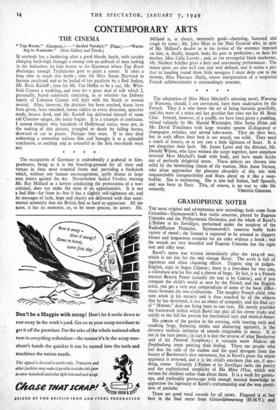GRAMOPHONE NOTES
THE most original and adventurous new recordings both come from Columbia—Szymanowski's first violin concerto, played by Eugenia Uminska and the Philharmonia Orchestra, and the whole of Ravel's L'Enfant et les Sortileges, performed under the auspices of the Radiodiffusion Francaise. Szymanowski's concerto badly lacks variety of mood ; the listener is expected to be attuned to slippery blisses and languorous ecstasies for six sides without a break ; but the sounds are very beautiful and Eugenia Uminska has the right taut and silky tone.
Ravel's opera was written immediately after the 1914-18 war, which is too late for the real vintage Ravel. The score is full of ingenious and often charming effects. Teapots sing in pidgin- English, cups in bogus Chinese; there is a love-duet for two cats, a coloratura aria for fire and a chorus of frogs. In fact, it is a French musical Beatrix Potter (actually the text is by Colette), and if you compare the child's world as seen by the French and the English artist, you get a very neat compendium of some of the basic differ- ences between the two civilisations. The naughty French child, who runs amok in his nursery and is then attacked by all the objects that he has destroyed, is not an object of sympathy, and his final cry of "Maman," does not bring tears to our eyes. He merely provides the framework within which Ravel can play all his clever tricks and satisfy to the full his passion for mechanical toys and musical-boxes.
His picture of the garden in the evening, with hooting owls and croaking frogs, fluttering moths and chattering squirrels, is the cleverest realistic imitation of sounds imaginable in music. It is not in the least poetic ; in fact it is just the reverse of what Beethoven said of his Pastoral Symphony ; it contains mehr Malerei als Empfindung, more painting than feeling. There are people who feel that the calls of the cuckoo and the quail derogate from the beauty of Beethoven's slow movement, but in Ravel's piece the whole approach is reversed, and it is the chilcrs emotions that are, if any- thing, otiose. Certainly L'Enfant et les Sortileges lacks the poetry and the sophisticated simplicity of Ma Mere l'Oye, which was written for children rather than about them. It is a work for grown- ups, and preferably grown-ups with enough musical knowledge to appreciate the ingenuity of Ravel's craftsmanship and the wan pretti- ness of pastiche.
There are good, vocal records for all tastes. Flagstad is at her best in the final scene from Gotterdiimmerung (H.M.V.). and Konetzni sings the Marschallin's monologue for Act i of Rosen- havalier (Col.) with great accomplishment. Tano Ferendinos displays a remarkably beautiful tenor in arias by Donizetti and Cilea (Col.), but both this and a record of Tito Gobbi (Pagliacci, H.M.V.) are spoiled by a bad surface. Janine Micheau gave me great pleasure with her Depuis le jour, and Gerard Souzay is unfailingly musicianly in some very Italianate and rather flimsy Gounod (both Decca).
Apart-from occasional bad surface, the Midsummer Night's Dream Overture, recorded by the Royal Philharmonic Orchestra under Beecham (H.M.V.), is excellent. Kodaly's Hary Janos Suite is the sort of music that takes the chromium-plated brilliance of the Philadelphia Orchestra under Eugene Ormandy (Col.) very well ; and the Conservatoire Orchestra under Ansermet give a different, deeper and subtler, brilliance to their Schgherazade (Decca). Campoli combines brilliance with sound musicianship in his playing of Bach's D minor sonata for unaccompanied violin (Decca) and builds up the great Chaconne well. Piatigorsky has recorded Brahms's D major 'cello sonata for Coluinbia, and Friedrich Gulda wastes some very good piano playing on Prokofiev's seventh piano sonata.
MARTIN COOPER.







































 Previous page
Previous page